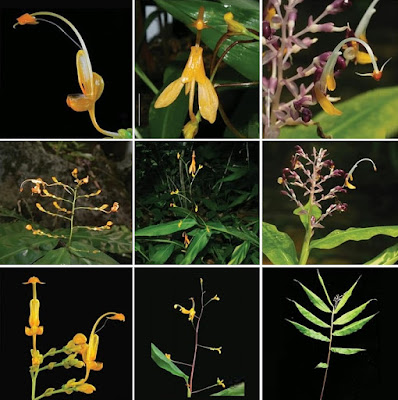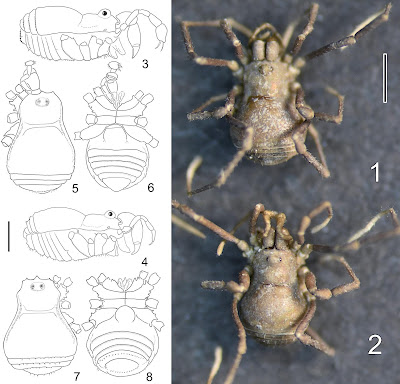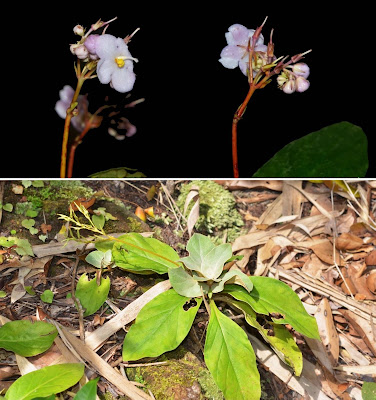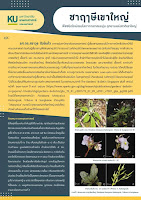[Most Recent Entries] [Calendar View]
Wednesday, June 2nd, 2021
| Time | Event | ||||||
| 4:26a | [Botany • 2021] Globba chrysantha, G. janae, G. larsenii, et al. • Eight New Species of Globba (Zingiberaceae) from Thailand and Lao PDR
Abstract Eight new species of Globba from Thailand and Lao PDR are described and illustrated; Globba chrysantha, G. janae, G. larsenii, G. longiligulata, G. luteola, G. mollis, G. poomae, and G. rupestris. Distribution maps and provisional IUCN assessments of each species are provided. Keywords: Dancing lady, ginger, Lao PDR, Thailand, Monocots Globba larsenii Sangvir. & M.F.Newman Globba longiligulata Sangvir. & M.F.Newman Globba poomae Sangvir. & M.F.Newman Sunisa Sangvirotjanapat and M.F.Newman. 2021. Eight New Species of Globba (Zingiberaceae) from Thailand and Lao PDR. Phytotaxa. 505(2); 139–156. DOI: 10.11646/phytotaxa.505.2.2 | ||||||
| 9:01a | [Arachnida • 2020] Suthepia inermis • A Mysterious Dwarf: Suthepiidae nov. fam., A New Harvestman Family (Opiliones: Laniatores) from Mountains of northern Thailand
Abstract A new family of laniatorean harvestmen from northern Thailand is proposed, Suthepiidae fam. nov., which comprises one new genus and one new species, Suthepia inermis sp. nov. This family stands out by characters hitherto unknown or rarely recorded for Opiliones, and close relatives of this taxon are presently not discernible. Important characters are a short and compact penis with a massively enlarged distal part with a rich armament of sclerites and membranes which can be moved and everted by hemolymph pressure during mating; the pedipalp of males and females is without raptorial adaptations, i.e. elevated sockets (= apophyses) carrying strong distal spines are completely absent, therefore no prey capture basket is present; the male pedipalpal tarsus is enlarged and compressed, its dorso-distal double apophysis presumably contains a gland; the pedipalpal claw is weak, not longer or stronger than long hyaline setae on the dorso-distal apophysis of the tarsus. The only specimens presently known were found in litter of a few forested mountain stocks, between 450 m and 1400 m altitude. A brief overview of Southeast Asian laniatorean families is presented. KEYWORDS: Supra-generic systematics, genital morphology, new genus, new species, Southeast Asia
Suborder Laniatores Thorell, 1876 Infraorder Grassatores Kury, 2003 Family Suthepiidae fam. nov. Type genus: Suthepia gen. nov. Included genera: Presently only one, the type genus. Diagnosis: A family of the order Opiliones, suborder Laniatores, infraorder Grassatores with the following characters: Small species with less than two mm body length. Body surface of males and females rather smooth, without conspicuous tubercles, thorns or setae. Penis stout, distal half strongly enlarged laterally and dorso-ventrally, with complex hemolymph-pressure-driven system of sclerites and membranes, with an eversible prickly funnel in its interior, and with pairs of single setae plus pairs of groups of setae. Ovipositor short, with three pairs of long sub-apical setae on ventral side. Pedipalp in males and females smooth, without any apophyses carrying setae (i.e. not the raptorial type of laniatorean pedipalps); tarsus of males enlarged, bilaterally compressed, with scattered distal setae slightly longer than and as strong as tarsal claw. Distribution: Presently only one species is known from mountains in northern Thailand. Relationships: Suthepiidae is unique in possessing several presumably apomorphic characters of the male and female pedipalp (non-raptorial type of pedipalps) and in its male and female genital morphology (stout, distally markedly enlarged penis with a complex eversible system including a prickly funnel; ovipositor with three pairs of slender sub-apical setae only on ventral side). Currently no close relationships to any extant Southeast Asian laniatorean family is discernible (see Discussion). Suthepia gen. nov. Type species: Suthepia inermis sp. nov. by monotypy and designation. Included species: Only the type species. Diagnosis: As given for the family Suthepiidae: Pedipalps not forming a catching basket, completely devoid of any apophyses carrying spines in both sexes; pedipalpal tarsus in males compressed and deepened, with apical setae more or less as long and strong as tarsal claw. Male genital morphology highly complex, with a complicated set of sclerites and membranes, with an eversible prickly funnel and with a complex arrangement of single setae and small groups of setae. Body largely unarmed, no conspicuous apophyses, thorns, granules or setae present. Small species with a body length of less than 2 mm. Name: The Latinized generic name refers to one of the localities of the type material, the Doi Suthep, a mountain in northern Thailand. The gender is female. Distribution: Currently known from four mountains of northern Thailand Suthepia inermis sp. nov. Diagnosis: A small species with a rather pyriform body, its dorsal side without tubercles or spines, with smooth surface; Tu oc low, broader than long, rounded. Chelicera strong, proximal article massively inflated in distal half. All articles of male pedipalp set with scattered setae, without apophyses and without spines; tarsus compressed and dorso-ventrally extended, with two rounded apophyses distally and dorso-distally, a smaller and a larger one, tarsal claw weak, not longer or stronger that longest apical seta. Female pedipalp generally as in male, but tarsus not enlarged and compressed, without apophyses, carrying a stronger claw. Name: The Latin adjective “inermis” means without weapons and refers to the largely unarmed body of males and females, devoid of tubercles, spines and large sensilla. Jochen Martens. 2020. A Mysterious Dwarf: Suthepiidae nov. fam., A New Harvestman Family from Mountains of northern Thailand (Arachnida: Opiliones: Laniatores). Revue suisse de Zoologie. 127(2); 381-391. DOI: 10.35929/RSZ.0028 | ||||||
| 10:01a | [Botany • 2021] Paraboea khaoyaica (Gesneriaceae) • A New Species from Khao Yai National Park, Thailand
ABSTRACT Paraboea khaoyaica Kaitongsuk, Triboun & Sungkaew, a new species from Southeastern Thailand, is described and illustrated and its conservation status is assessed. The species is currently only known from the type locality. Keywords. Asia, endangered, Khao Yai National Park
Paraboea khaoyaica Kaitongsuk, Triboun & Sungkaew, sp. nov. Paraboea khaoyaica is similar to Paraboea pubicorolla Z.R.Xu & B.L.Burtt in having 1–3 subterminal inflorescences, leaves that are elliptic or ovate and with narrow wings at the base of the petiole joining across the nodes, and, unusually for species in the genus, occurs in a similar sandstone habitat. It differs in having a glabrous and flatfaced campanulate corolla with tube 4–5 mm long (vs a glandular hairy and deeply campanulate corolla with tube c. 7 mm long in Paraboea pubicorolla), filaments 1.5–2 mm long and glabrous (vs c. 4 mm long and pubescent in P. pubicorolla), and capsules 1–1.5 cm long (vs 2.5–3 cm long in P. pubicorolla). Paraboea khaoyaica is also similar to P. chumphonensis Triboun in the similar size of leaves and its flatfaced campanulate corolla with tube c. 4 mm long. It differs, however, in having a glabrous ovary (vs pubescent ovary in Paraboea chumphonensis), slightly shorter and glabrous capsules 1–1.5 cm long (vs slightly longer capsules c. 1.8 cm long which are covered with glandular hairs in P. chumphonensis), and occurrence in a sandstone habitat (vs limestone habitat in P. chumphonensis). Distribution. Endemic to Southeastern Thailand. Ecology. Growing on sandstone rocks along a stream and on moist rocks in partial shade in bamboo and dry dipterocarp forest, alt. 100–150 m. Etymology. The specific epithet refers to Khao Yai National Park (the type locality). Vernacular name. Cha Rue Si Khao Yai (ชาฤๅษีเขาใหญ่). Saksan Kaitongsuk, Pramote Triboun, Somran Suddee, Phasit Ue-Aree and Sarawut Sungkaew. 2021. Paraboea khaoyaica (Gesneriaceae), A New Species from Thailand. Gardens’ Bulletin Singapore. 73(1); 203–207. DOI: 10.26492/gbs73(1).2021-09 |
| << Previous Day |
2021/06/02 [Calendar] |
Next Day >> |

















